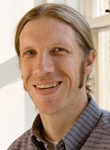Students take America's pulse in course on polling
By Bill Steele


Are we doing enough about climate change? Do people trust the police? Where should schools cut corners? Do you trust stores with your private information?
Let’s find out what people think. Let’s take a poll.
Not as easy as it sounds, but Cornell will teach you how to do it – and how to evaluate the results when someone else claims to have done it.
“We live in a world full of data,” said Peter Enns, assistant professor of government, explaining why he helped to create Taking America’s Pulse (Govt/Comm 3189), a course in which students design, conduct and analyze a real national public opinion poll. When they’re done, Enns said, the 45 students will not only know how to conduct a poll, but will “look at polls with a critical eye.”
Enns co-teaches the course with Jonathon Schuldt, assistant professor of communication. It is one of 14 interdisciplinary “university courses,” open to students in any college.
After a crash course in statistics and other basics, students work in small groups to select a topic, frame questions, conduct a telephone survey, analyze the data and finally, write and submit for publication an op-ed article describing the significance of their findings. Topics covered this year included attitudes toward social media, how retailers use the data they collect on consumers, policies on climate change, what “frills” schools should cut from their budgets, and government spending on war and welfare.
Students work with Cornell’s Survey Research Institute (SRI), which provides facilities for telephone polling and trains the students in interview technique. SRI personnel do some of the calling, but every student gets to take part, in the process learning how results can be affected by the way questions are asked and what can go wrong if respondents misunderstand.
SRI used randomized dialing to reach mobile and landline phones throughout the contiguous United States, from which 563 interviews were completed. The various questions created by the students were combined into a single large survey, making each interview about half an hour long. Predictably, the students learned about interruptions, callbacks and incomplete interviews.
Each interview concluded with a list of profile questions such as the respondent’s age, gender, income level and political and religious affiliation, which enabled the students to correlate opinions with those characteristics. The results were sometimes serendipitous. One student, Max Schechter ‘14, set out with the simple goal of finding out where people planned to go the next time they moved, and discovered that respondents chose destinations that matched their political beliefs: conservatives plan to move to red states, and liberals to blue. As a result, he predicted in an op-ed article in the Cornell Daily Sun, states may become more polarized and swing states may disappear.
The semester culminated in a poster session May 12 where the students displayed their results, usually with an array of pie charts and bar graphs. Highlighjts of the results are being posted online as they becomem available.
University courses are supported by the Vice Provost for Undergraduate Education. The Vice Provost for Research supplied additional funding for this course, and the Survey Research Institute provided its services at a discount.
Media Contact
Get Cornell news delivered right to your inbox.
Subscribe